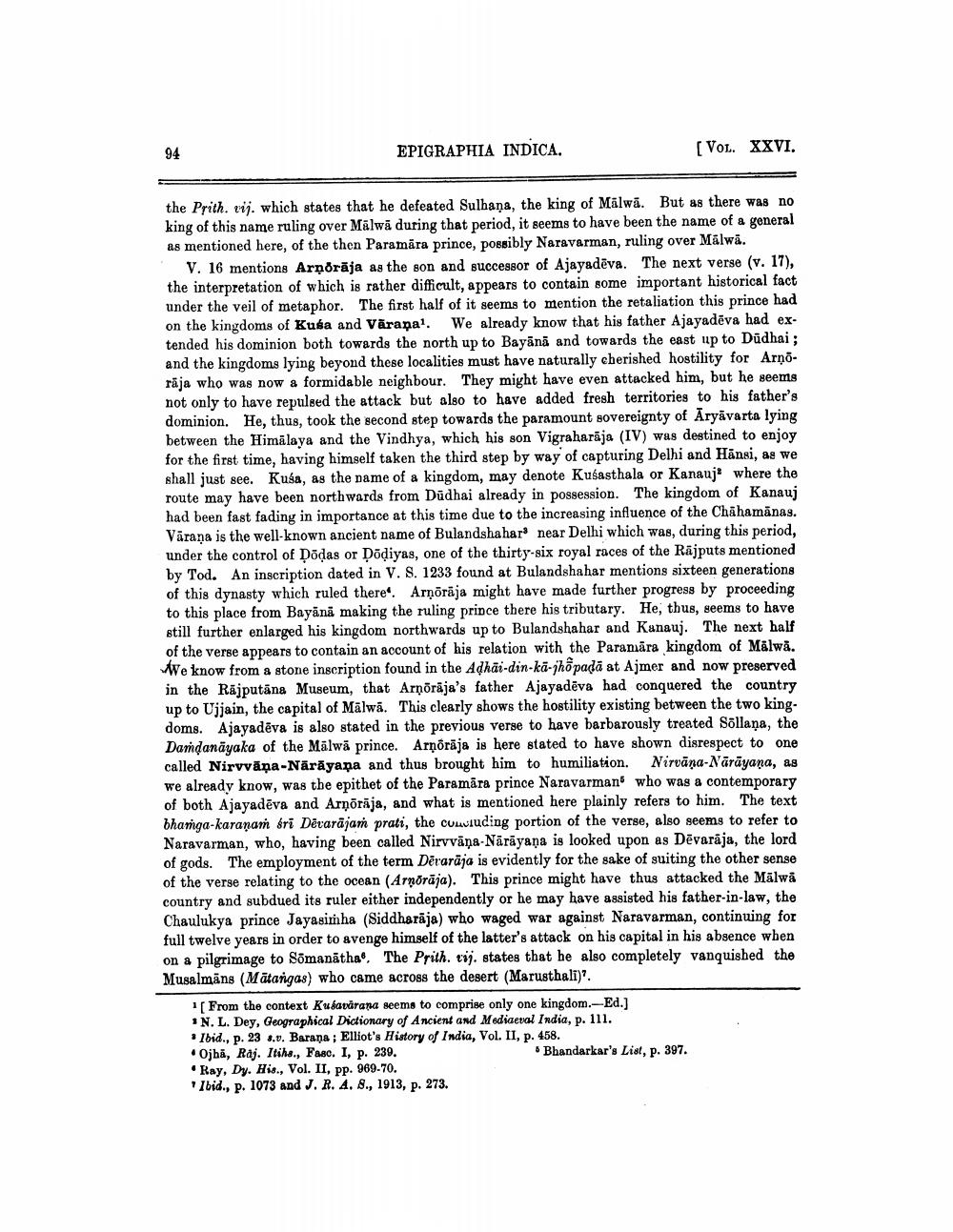________________
94
EPIGRAPHIA INDICA,
(VOL. XXVI.
the Prith. vij. which states that he defeated Sulhana, the king of Mālwā. But as there was no king of this name ruling over Mālwă during that period, it seems to have been the name of a general as mentioned here, of the then Paramāra prince, possibly Naravarman, ruling over Malwa.
V. 16 mentions Arnorāja as the son and successor of Ajayadēva. The next verse (v. 17), the interpretation of which is rather difficult, appears to contain some important historical fact under the veil of metaphor. The first half of it seems to mention the retaliation this prince had on the kingdoms of Kusa and Vārapal. We already know that his father Ajayadēva had extended his dominion both towards the north up to Bayānā and towards the east up to Dūdhai; and the kingdoms lying beyond these localities must have naturally cherished hostility for Arņorāja who was now a formidable neighbour. They might have even attacked him, but he seems not only to have repulsed the attack but also to have added fresh territories to his father's dominion. He, thus, took the second step towards the paramount sovereignty of Aryävarta lying between the Himalaya and the Vindhya, which his son Vigraharāja (IV) was destined to enjoy for the first time, having himself taken the third step by way of capturing Delhi and Hänsi, as we shall just see. Kuća, as the name of a kingdom, may denote Kuśasthala or Kanaujo where the route may have been northwards from Dūdhai already in possession. The kingdom of Kanauj had been fast fading in importance at this time due to the increasing influence of the Chāhamānas. Vārana is the well-known ancient name of Bulandshahar near Delhi which was, during this period, under the control of Dödas or Dodiyas, one of the thirty-six royal races of the Rājputs mentioned by Tod. An inscription dated in V. S. 1233 found at Bulandshahar mentions sixteen generations of this dynasty which ruled there. Arņorāja might have made further progress by proceeding to this place from Bayānā making the ruling prince there his tributary. He, thus, seems to have still further enlarged his kingdom northwards up to Bulandshahar and Kanauj. The next half of the verse appears to contain an account of his relation with the Paramāra kingdom of Mālwă. We know from a stone inscription found in the Adhāi-din-kā-jhõpada at Ajmer and now preserved in the Rajputana Museum, that Arnorāja's father Ajayadēva had conquered the country up to Ujjain, the capital of Mälwā. This clearly shows the hostility existing between the two kingdoms. Ajayadēva is also stated in the previous verse to have barbarously treated Söllana, the Damdanāyaka of the Mālwă prince. Arņõrāja is here stated to have shown disrespect to one called Nirvväņa-Nārāyana and thus brought him to humiliation. Nirvana-Nārāyana, as we already know, was the epithet of the Paramāra prince Naravarman who was a contemporary of both Ajayadēva and Arņörāja, and what is mentioned here plainly refers to him. The text bhanga-karanan Sri Dērarājam prati, the couvluding portion of the verse, also seems to refer to Naravarman, who, having been called Nirvvāņa-Nārāyana is looked upon as Dēvaraja, the lord of gods. The employment of the term Dērarāja is evidently for the sake of suiting the other sense of the verse relating to the ocean (Arnorāja). This prince might have thus attacked the Mālwa country and subdued its ruler either independently or he may have assisted his father-in-law, the Chaulukya prince Jayasimha (Siddharāja) who waged war against Naravarman, continuing for full twelve years in order to avenge himself of the latter's attack on his capital in his absence when on a pilgrimage to Sõmanātha The Prith. tij. states that he also completely vanquished the Musalmāns (Mätangas) who came across the desert (Marusthali).
[ From the context Kusavarana seems to comprise only one kingdom.-Ed.] *N. L. Dey, Geographical Dictionary of Ancient and Mediaeval India, p. 111. • Ibid., p. 23 .v. Barana : Elliot's History of India, Vol. II, p. 458. Ojha, Raj. Itihs., Faac. I, p. 239.
Bhandarkar's List, p. 397. • Ray, Dy. His., Vol. II, pp. 969-70. Ibid., p. 1073 and J. R. A. 8., 1913, p. 273.




